翻译批评与赏析概
- 格式:ppt
- 大小:774.50 KB
- 文档页数:10
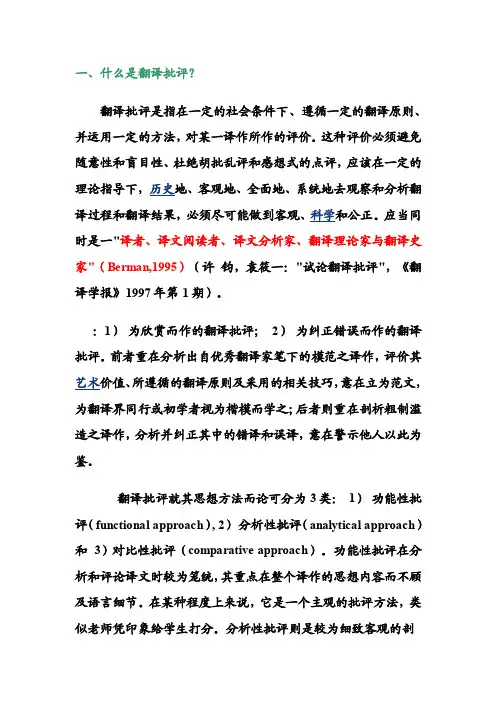
一、什么是翻译批评?翻译批评是指在一定的社会条件下、遵循一定的翻译原则、并运用一定的方法,对某一译作所作的评价。
这种评价必须避免随意性和盲目性、杜绝胡批乱评和感想式的点评,应该在一定的理论指导下,历史地、客观地、全面地、系统地去观察和分析翻译过程和翻译结果,必须尽可能做到客观、科学和公正。
应当同时是一"译者、译文阅读者、译文分析家、翻译理论家与翻译史家"(Berman,1995)(许钧,袁筱一:"试论翻译批评",《翻译学报》1997年第1期)。
:1)为欣赏而作的翻译批评;2)为纠正错误而作的翻译批评。
前者重在分析出自优秀翻译家笔下的模范之译作,评价其艺术价值、所遵循的翻译原则及采用的相关技巧,意在立为范文,为翻译界同行或初学者视为楷模而学之;后者则重在剖析粗制滥造之译作,分析并纠正其中的错译和误译,意在警示他人以此为鉴。
翻译批评就其思想方法而论可分为3类:1)功能性批评(functional approach), 2)分析性批评(analytical approach)和3)对比性批评(comparative approach)。
功能性批评在分析和评论译文时较为笼统,其重点在整个译作的思想内容而不顾及语言细节。
在某种程度上来说,它是一个主观的批评方法,类似老师凭印象给学生打分。
分析性批评则是较为细致客观的剖析,译文中的每一个词语、每一句话、每一语段和段落都会对照原文加以对比和分析,错误的译文被分门别类地挑出来加以评论,并提出改进意见;好的译文挑出来加以褒扬。
对比性批评是选择同一原作的若干种译文,同时采用译文与原文对比、译文与译文对比的方法找出各自的优劣之处。
好的加以褒奖,劣的予以批评。
翻译批评有助于克服翻译界存在的滥译、乱译等问题,因而对繁荣我国翻译事业有着不可低估的现实意义和深远的历史意义;翻译批评有助于纠正译作中出现的错误、改进不足,因而对提高译文的质量有着积极的作用;翻译批评还是联系翻译理论和翻译实践的重要桥梁,因为任何翻译理论的建立均有待于翻译实践的检验;反之,任何翻译实践都会自觉或不自觉地遵循一定的翻译理论。
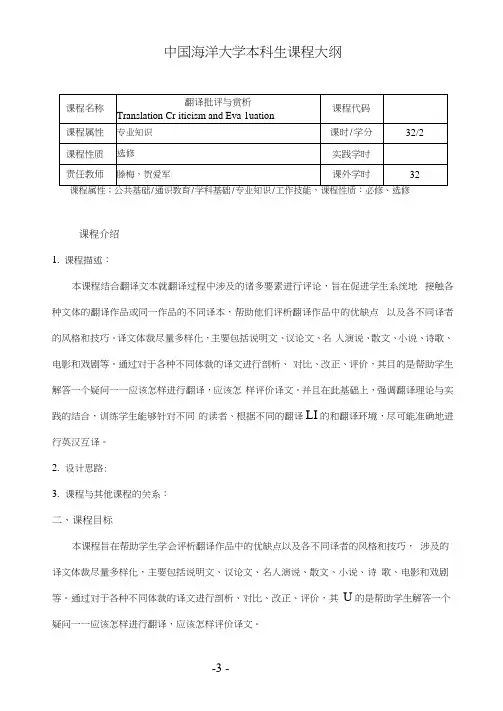
中国海洋大学本科生课程大纲课程介绍1.课程描述:本课程结合翻译文本就翻译过程中涉及的诸多要素进行评论,旨在促进学生系统地接触各种文体的翻译作品或同一作品的不同译本,帮助他们评析翻译作品中的优缺点以及各不同译者的风格和技巧。
译文体裁尽量多样化,主要包括说明文、议论文、名人演说、散文、小说、诗歌、电影和戏剧等。
通过对于各种不同体裁的译文进行剖析、对比、改正、评价,其目的是帮助学生解答一个疑问一一应该怎样进行翻译,应该怎样评价译文。
并且在此基础上,强调翻译理论与实践的结合,训练学生能够针对不同的读者、根据不同的翻译LI的和翻译环境,尽可能准确地进行英汉互译。
2.设计思路:3.课程与其他课程的关系:二、课程目标本课程旨在帮助学生学会评析翻译作品中的优缺点以及各不同译者的风格和技巧,涉及的译文体裁尽量多样化,主要包括说明文、议论文、名人演说、散文、小说、诗歌、电影和戏剧等。
通过对于各种不同体裁的译文进行剖析、对比、改正、评价,其U的是帮助学生解答一个疑问一一应该怎样进行翻译,应该怎样评价译文。
三、学习要求(1)按时上课,上课认真听讲,积极参与课堂讨论、随堂练习和测试。
本课程将包含较多的随堂练习、讨论、小组作业展示等课堂活动,课堂表现和出勤率是成绩考核的组成部分。
(2)按时完成常规练习作业。
这些作业要求学主按书面形式提交,只有按时提交作业,才能掌握课程所要求的内容。
延期提交作业需要提前得到任课教师的许可。
(3)完成教师布置的一定量的阅读文献和背景资料等作业,其中部分内容要求以小组合作形式完成。
这些作业能加深对课程内容的理解、促进同学间的相互学习、并能引导对某些问题和理论的更深入探讨。
四、教学进度五.参考教材与主要参考书1 ・ Reiss, Katharina. Translation Criticism: The Potentials and Limitations [MJ.上海: 上海外语教育出版社,2004.2.崔永禄.文学翻译佳作对比赏析[M].天津:南开大学出版社,2001.3.姜治文、文军.翻译批评论[M].重庆:重庆大学出版社,1999.4.马红军.翻译批评散论[M].北京:中国对外翻译出版公司,2000.5.王宏印.文学翻译批评论稿[M].上海:上海外语教育出版社,2005.6.杨晓荣.翻译批评导论[M].中国对外翻译出版公司,2005.7.许钧.文学翻译批评研究[M]・南京:译林出版社,1992.六、成绩评定(-)考核方式—:A.闭卷考试B.开卷考试C.论文D.考查E.其他(二)成绩综合评分体系:附:作业和平时表现评分标准1)作业的评分标准七.学术诚信学习成果不能造假,如考试作弊、盗取他人学习成果、一份报告用于不同的课程等,均属造假行为。
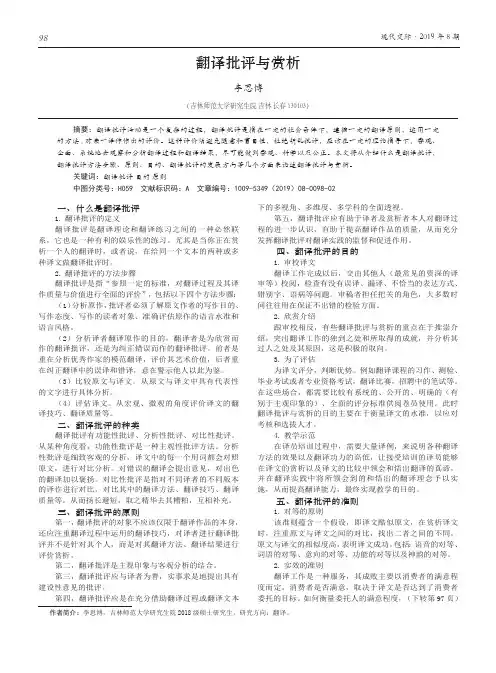
98现代交际·2019年8期作者简介:李思博,吉林师范大学研究生院2018级硕士研究生,研究方向:翻译。
翻译批评与赏析李思博(吉林师范大学研究生院 吉林 长春 130103)摘要:翻译批评活动是一个复杂的过程,翻译批评是指在一定的社会条件下,遵循一定的翻译原则,运用一定的方法,对某一译作作出的评价。
这种评价须避免随意和盲目性,杜绝胡乱批评,应该在一定的理论指导下,客观、全面、系统地去观察和分析翻译过程和翻译结果,尽可能做到客观、科学以及公正。
本文将从介绍什么是翻译批评,翻译批评方法步骤、原则、目的、翻译批评的发展方向等几个方面来论述翻译批评与赏析。
关键词:翻译批评 目的 原则中图分类号:H059 文献标识码:A 文章编号:1009-5349(2019)08-0098-02一、什么是翻译批评1.翻译批评的定义翻译批评是翻译理论和翻译练习之间的一种必然联系,它也是一种有利的娱乐性的练习。
尤其是当你正在赏析一个人的翻译时,或者说,在给同一个文本的两种或多种译文做翻译批评时。
2.翻译批评的方法步骤翻译批评是指“参照一定的标准,对翻译过程及其译作质量与价值进行全面的评价”,包括以下四个方法步骤:(1)分析原作,批评者必须了解原文作者的写作目的、写作态度、写作的读者对象、准确评估原作的语言水准和语言风格。
(2)分析译者翻译原作的目的,翻译者是为欣赏而作的翻译批评,还是为纠正错误而作的翻译批评。
前者是重在分析优秀作家的模范翻译,评价其艺术价值,后者重在纠正翻译中的误译和错译,意在警示他人以此为鉴。
(3)比较原文与译文。
从原文与译文中具有代表性的文字进行具体分析。
(4)评估译文。
从宏观、微观的角度评价译文的翻译技巧、翻译质量等。
二、翻译批评的种类翻译批评有功能性批评、分析性批评、对比性批评。
从某种角度看,功能性批评是一种主观性批评方法。
分析性批评是细致客观的分析,译文中的每一个用词都会对照原文,进行对比分析。
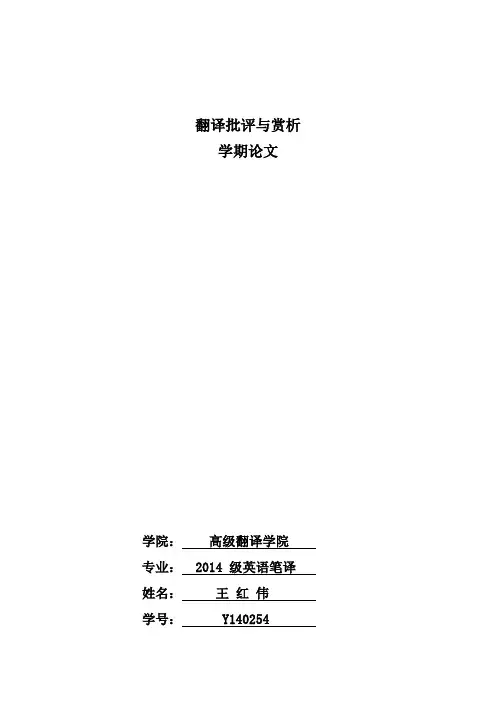
翻译批评与赏析学期论文学院:高级翻译学院专业: 2014 级英语笔译姓名:王红伟学号: Y140254前言学习感悟本学期有幸选了陈老师开设的选修课—翻译批评与赏析,陈老师授课方式新颖独到,以德国功能翻译理论学派重要代表人物凯瑟琳娜·赖斯的《翻译批评:潜力与制约》一书为主线,以学生讲解老师总结答疑为主要方法,并穿插有课堂讨论,让学生各抒己见,畅所欲言,一学期的学习让我收获颇丰。
在未上陈老师的课之前,自己的翻译批评往往多是感性的翻译评论,没有系统的批评理念与批评模式,面对一个译本,只会从表层进行主观评判,既缺乏系统性又不具有客观性,难以服众。
经过一学期的学习我认识到翻译批评绝不是为了批评而批评,更不能带有学术偏见而起意气之争,相互攻讦,翻译批评应该是建设性的,必须公正、客观、全面,有理有据。
作为翻译专业研究生,更应该对翻译批评认真加以学习,用全面的眼光看待翻译,树立科学的翻译批评观,并将其用于指导、审视自己的翻译活动。
翻译批评的文本功能视角—兼评赖斯的文本类型理论摘要:凯瑟琳娜·赖斯是德国功能派翻译理论的主要奠基者,在其扛鼎之作《翻译批评:潜力与制约》中赖斯借鉴德国心理学家布勒的语言功能划分模式将文本划归为三种基本类型:信息型文本、表情型文本和操作型文本,并建议根据文本功能采取相应的翻译方法。
本文从赖斯的文本类型理论着手,结合不同文本译例,并对之加以述评。
关键词:赖斯;翻译批评;文本类型;文本功能;《翻译批评:潜力与制约》1. 引言凯瑟琳娜·赖斯(Katharina Reiss)是德国功能派翻译理论研究的先驱,1971年赖斯出版了其扛鼎之作《翻译批评:潜力与制约》“是德国从语言功能角度切入翻译研究的开端作品”,(陈吉荣,2007:3)赖斯在该书中以文本类型理论为基本框架,试图建构一个客观、可行、全面的翻译批评模式。
赖斯的文本类型理论基本沿用了德国心理学家布勒的语言功能三分法影响,根据布勒的语言功能工具模式,赖斯把文本划分为三种主要类型,即信息型文本、表情型文本和操作型文本(亦称感染型)。
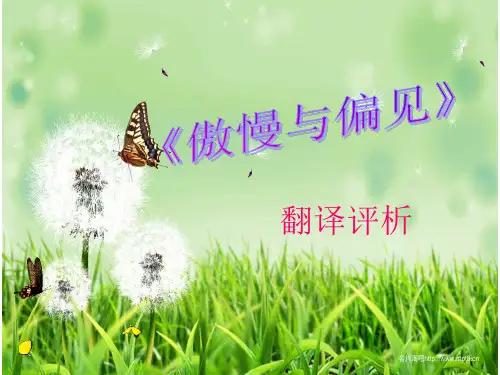

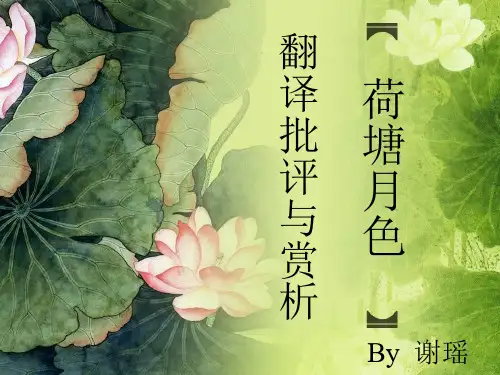
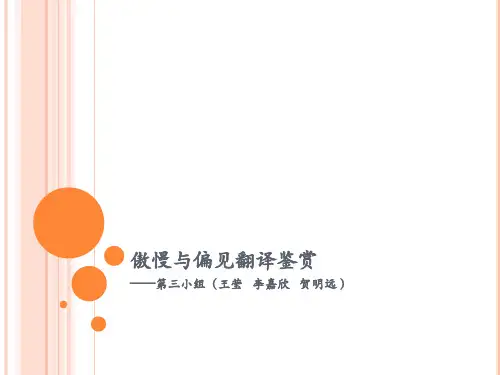
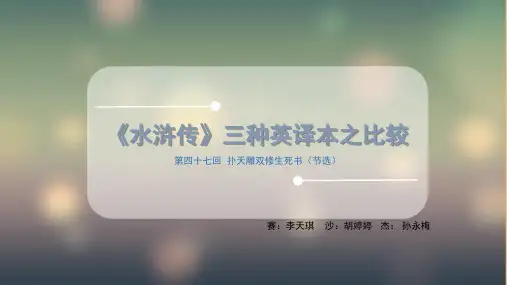
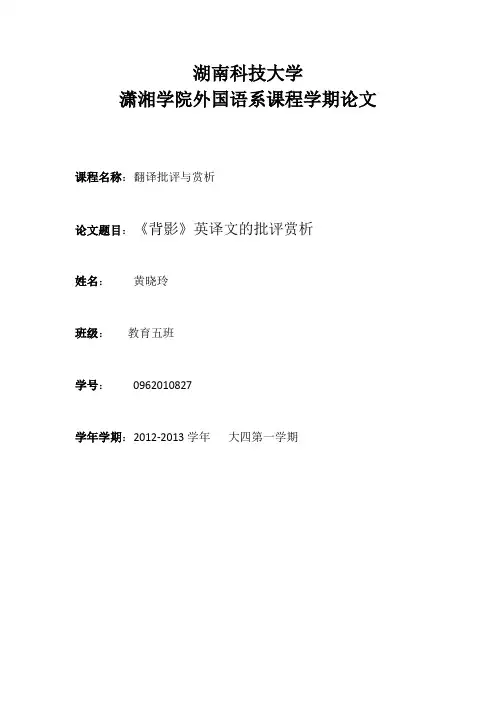
湖南科技大学潇湘学院外国语系课程学期论文课程名称:翻译批评与赏析论文题目:《背影》英译文的批评赏析姓名:黄晓玲班级:教育五班学号:0962010827学年学期:2012-2013学年大四第一学期《背影》英译文的批评赏析摘要: 朱自清的代表作《背影》堪称散文界的抒情名篇。
而英译《背影》不仅在内容上忠实于原文, 更做到了英汉翻译中从中文的主观视角到英文的客观视角的灵活切换。
关键词: 背影; 主客观视角; 切换Abstract: Zhu Ziqing's The Sight of Father's Back is one of the most famous essays in China. Zhang Peiji's English Version not only keeps loyal to the original contents but also realizes the translation tar-get of the proper change from subjective perspective to objective per -spective.Key words: The Sight of Father's Back; subjective and objective persp ectives; change关于《背影》:说起文学作品的翻译, 不免总要谈到中外民族思维上的差异。
中国人推崇“天人合一”,“万物皆备与我”, 表现在中国人的思维之中, 人与自然的关系是物我合一, 主客观是统一的, 而在人与物的和谐关系中, 人是主导的, 有强烈的主观(subjective)意识。
而西方人崇尚理性, 人与物保持距离, 站在客观理性的角度去分析观察事物, 因此, 语言的表达是从客观视角(objective pe rspective)出发的。
《背影》是我国“五四”时期最出色的散文家之一朱自清的代表作, 堪称散文界的抒情名篇。
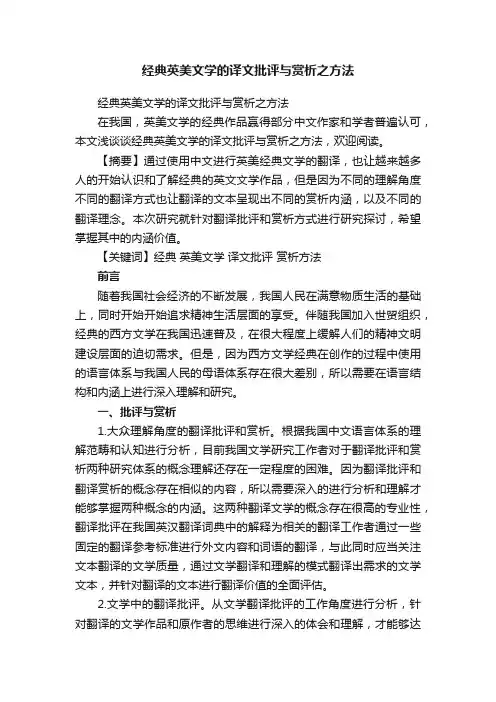
经典英美文学的译文批评与赏析之方法经典英美文学的译文批评与赏析之方法在我国,英美文学的经典作品赢得部分中文作家和学者普遍认可,本文浅谈谈经典英美文学的译文批评与赏析之方法,欢迎阅读。
【摘要】通过使用中文进行英美经典文学的翻译,也让越来越多人的开始认识和了解经典的英文文学作品,但是因为不同的理解角度不同的翻译方式也让翻译的文本呈现出不同的赏析内涵,以及不同的翻译理念。
本次研究就针对翻译批评和赏析方式进行研究探讨,希望掌握其中的内涵价值。
【关键词】经典英美文学译文批评赏析方法前言随着我国社会经济的不断发展,我国人民在满意物质生活的基础上,同时开始开始追求精神生活层面的享受。
伴随我国加入世贸组织,经典的西方文学在我国迅速普及,在很大程度上缓解人们的精神文明建设层面的迫切需求。
但是,因为西方文学经典在创作的过程中使用的语言体系与我国人民的母语体系存在很大差别,所以需要在语言结构和内涵上进行深入理解和研究。
一、批评与赏析1.大众理解角度的翻译批评和赏析。
根据我国中文语言体系的理解范畴和认知进行分析,目前我国文学研究工作者对于翻译批评和赏析两种研究体系的概念理解还存在一定程度的困难。
因为翻译批评和翻译赏析的概念存在相似的内容,所以需要深入的进行分析和理解才能够掌握两种概念的内涵。
这两种翻译文学的概念存在很高的专业性,翻译批评在我国英汉翻译词典中的解释为相关的翻译工作者通过一些固定的翻译参考标准进行外文内容和词语的翻译,与此同时应当关注文本翻译的文学质量,通过文学翻译和理解的模式翻译出需求的文学文本,并针对翻译的文本进行翻译价值的全面评估。
2.文学中的翻译批评。
从文学翻译批评的工作角度进行分析,针对翻译的文学作品和原作者的思维进行深入的体会和理解,才能够达成翻译批评和赏析的需求。
很多时候不能够完全的理解和掌握翻译文学原作者的思维,就需要进行文学作品的深入解读,通过联系常这个文学作品、翻译文本工作者和读者之间的关系,进一步在翻译文学作品中体会其文学价值和内涵,这也是翻译批评工作三个重要的组成部分。
翻译批评与赏析课程实训(一)实训目的:学习找到批评的视角并有理有据地对两种译文进行批评性赏析;实训要求:将所学的批评模式一应用到该段汉译英的短文中,首先独立翻译,之后进行赏析性评价并形成报告;附:可怕的习惯和朋友一起上街,顺便到一个杂志亭买一本杂志。
身上没带零钱,就将一张50元递了过去。
不一会,一堆零钱带着愤怒的情绪啪啪的一声扔到我面前。
我若无其事地将零钱收起来。
朋友说,他这样做是对人的不尊重。
我说,我早已习惯了。
确实是习惯了—对恶劣的服务不生气,不争辩,不拒绝,听之任之,逆来顺受。
忽然觉得这习惯很可怕,原来你的不被尊重是你的不要求造成的。
结果,你习惯了,别人也习惯了。
更可怕的是:我竟然为没带零钱羞愧。
A horrible habitHanging out with friends, I bought a magazine at a magazine booth. Without any small changes, I gave 50 yuan to the boss and the boss threw the a lot of changes in front of me angrily. I Picked them up just like nothing happened. But my friend said, he didn’t respect you. I told him that I had used to it. I really get used to the wicked service without angry and argument and just accept it. I suddenly feel horrible that your being disrespected is resulted by your no asking for it. In the end, we all get used to it. What’s more horrible is that I do not feel shameful for not having changes.译文一:A Terrible HabitI was walking in the street in the company of a friend. On the way, I went near a kiosk to buya magazine. Having no banknote of lower value with me, I just handed a 50 yuan note to the keeper inside. In a second, a small pile of small change angrily crashed down before me.I picked it up as if nothing had happened.“He was very rude,” my friend commented. I replied, “ I’ve got used to it, for a long time.”So used to it that I felt no anger at all, accepting it meekly, making no complaint or protest.All of a sudden, I found this habit very terrible. Other people showing no respect to you is the result of your not asking for it. Consequently, your habit gives rise to other people’s habit.What’s more terrible is that I feel ashamed of not having with me notes of small denominations.译文二:A Horrible HabitI went shopping with a friend and on the way bought a magazine at a kiosk. Without any change on me, I gave a note of 50 yuan and took/received a lot of change which was thrown with anger to me. I picked up the change as if nothing happened. But my friend said, his conduct is a kind of disrespect. And I have been used to it was my reply.I am used to that kind of conduct indeed which can be reflected by my attitude of not being angry, no argument and no refusal towards terrible service. Grin and bear is all what I can do.Suddenly I became aware that this habit could be very horrible as the disrespect to me arises from my not asking for it. And once we become used to it, they will be used to their conduct too.What’s more horrible is that: I even feel ashamed for not carrying change with me.。
翻译批评与赏析之天净沙·秋思院系:班级:姓名:学号:Analysis and Comparison of Different English V ersions of A Chinese Qu-poetry-Tian-Jing-Sha-QiuSiAbstract:With the development of state economy and the improvement state power, china has a greater and greater influence in the world, and Chinese culture becomes more and more popular around the world.In order to satisfy the needs of the foreigners and spread our culture more wildly, many Chinese works have been translated into English,however,different translators may translate the same work different according to their own understanding.This paper means to find out the similarities and differences between the Chinese originals and their translations, and analysis the various advantages and disadvantages of each version, pointing out whether the versions are acceptable or not.Key words: transition Tian-Jing-Sha--Qiu Si versionI IntroductionTian-Jing-Sha-Qiu Si,a Chinese Qu-poetry,is wrote by Ma Zhiyuan who was a famous Qu composer regraded as Libai(a well-known poet) in the Tang dynasty(618-907AD)and Sushi(a well-known Ci-composer)in the Song dynasty(960-1279AD) and was known for his bold and unconstrained styled Yuan Sanqu (a type of verse popular in the Yuan, Ming and Qing dynasties, with tonal patterns modelled on tunes drawn from folk music),while this poemis a lyric poetry to express the deep homesick of a man travelling or residing far away from home.This poem is very famous and was regarded as the forefather of QiuSi by Zhou Deqing in his famous book ZhongY uanYinY un and was praised as the sound of nature by W ang Guowei in his Song Y uan Xi Qu Kao and in his renowned Ren Jian Ci Hua he also said very few words fully revealed the excellent of the Tang poetry which can not be done by the all the Y uan poets except Ma Zhiyuan.II.The Chinese original versionIn Chinese original version ,this poem was consisted of only 28 words including only 10 subjects and one person . There is not a single common saying ,a slang or a function word in the whole poet. It seems that the poet just links some unrelated things together without the using of verbs or linking words to unfold us a impressive image to express the great homesick of the person who is far away from home.III.Analysis and comparisonThere are many translated versions about the Tian-Jing-Sha-Qiu Si, and I am going to make a analysis and comparison among the following five versions translated by a)W ong Xianliang b) Ding Zuxing and Burton Raffel c)ZhaoZhentao d)Wayne Schlepp e)Zhou Fangzhu.As the first three verses have the same patten, I decide to analysis them together.(1)the first three versesWong's version:Crows hovering over rugged trees wreathed with rotten vine —the day is about done. Yonder is a tiny bridge over a sparkling stream, and on the far bank, a pretty little villageDing and R's version:Withered vines hanging on old branches,Returning crows croaking at dusk.A few houses hidden past a narrow bridge,And below the bridge a quiet creek running. /Zhao's version:Withered vines, olden tree, ev [e] ning crows;Tiny bridge, flowing brook, hamlet homes;Ancient road, wind from west, bony horse; /Schlepp's versionDry vine, old tree, crows at dusk,Low bridge, streamrunning, cottages,Ancient road, west wind, lean nag,Zhou's versionWithered vine, old tree, crows at dusk,Tiny bridge, flowering brook, and cottages,Ancient road, blesk wind, bony steed.From the versions above it is not difficult for us to see that the last three versions are of the same patterns.They keep the same pattern with the original version.what different is the wording.The Analysis of W ong's version:W ong derestroy the original pattern and adopt the way to paraphrase and also add something to the version for example and on the far bank so as to convey us information more correctly. However, this kind of translation loses the original pithiness and penetratingness ,what is more, it also express us so mush that it limit our imagination.While, the wording of this version is very good, the word hovering he used presents us a much more vivid picture to show the scene how the crows are flying. There are also other words such as rugged ,wreathed,rotten making the image more vividly. But the word sparkling is unsuitable for it conveys a mirthfully atmosphere while the whole poet is sad and sorrow. The analysis of the second version: this version is just the same as the first version as for the pattern for it also does notfollow the original pattern and wording.while the second also has something special,in the original poet all the images are of equal importance and they are place paralleled that is to say there is no attribution relationships among there.however, in the second version,Withered vines hanging on old branches,Returning crows croaking at dusk. It seems that the old branches is just a setting for vines are and crows,they are no more paralleled,thus the translator changes the original three images to two scenes.And it goes the same as the next verse, the translator chooses the bridge as the setting thus changing the three images to two scenes.The Analysis of the last three version:just as what has said above,the last three versions have something in common,that is they are all of the same pattern which is almost the same as the original version, which leaves us a great of imaginary space just as what the poet intents to .while, there is still difference them that is the choosing of the word.Of course they all have their shining points in their wording, here i just want to mention the translation of a noun phrase xifeng,in china xifeng blows in winter when everything is bloom therefore it symbolizes cold suffering and misery. While in the western ,xifeng blows in spring when everything comes back to life therefore itsymbolizes life , recovery and hope. So I think to translate xifeng directly into westwind is not appropriate.(2) The forth verseFor Wong has amalgamated the last two verses into one,so I will analysis it together with the firth verse soon afterward.Ding and R's version: The sun dips down in the westZhao's version:The sun is settingSchlepp's version: The sun westeringZhou's version:The sun sinking westReading the original poetry carefully you will easily have a feeling that this verse is not only means to state the fact that the sun is westering but also try to present us an image.Of the four versions I think the first is the best for the translator uses a verb dip which not only shows us the dynamical process of the fallen of the sun but also gives an impression that the sun is further and further.while,the other three translations just show us the action of the sun without the image represented by the sun.while,among the three zhou's version is better,for a word sinking does not only means the sun fallen in the west but also shows the the sense of heaviness of the sun, what is more, sinking also vividly present the sadness and helpless of theperson who is far away from home.All in all, all of the four translations convey the original poetry truthfully and leave us great imaginary space.(3) the last verseWong's version:But the traveler has to go on down this ancient road, the westwind moaning, his bony horse groaning, trudging towards the sinking sun, farther and farther away fromhome.Ding and R's version:And the lovesick traveler is still at the end of the world.Zhao's version:Broken man, far fromhome, roams and roams.Schlepp's versionAnd one with breaking heart at the sky’s edgeZhou's version:A heart-torn traveler at the end of the world.In Chinese,zai is a verb and later with the development of the language it changes to preposition.while, in the original poetry the second noun phase is a place and it is just in this place that the first noun phase located. While,Among the five translations, only the second adopts the same process of the original poetry, it use the verb is to translate the Chinese zai.Butwhat deserves our attention is that the translator still add a adverb still to his version,here still is a commentary adverb in functional grammar which is used to demonstrate the author's opinion.Therefore, by adding a still the translator puts his own opinion into his translation thus limiting the readers' imaginary space intangibly.While I think W ong's version is a little better for he translates the last two verses into four minor sentences to express four dynamical scenes which makes the original statical scenery dynamical and vivid. what is more, the relationship between the horse and traveller has not been pointed out while in his translation the relationship is very clear thus making the scene more clear.Roam in the third translation is not suitable for roam means wander or walk aimless or without destination, it is usually used to express one's confusion.while the original poetry does not mean to convey us so.It is easy to find that Schlepp's version and Zhou's version are very similar for they both translate into a noun phase plus a prepositional phase and they all chose the preposition at, while at has many meanings and only it used together with verbs orothers can it conveys a complete meaning. So from this sense, both of the two versions do not have a clear relationship between the first noun phase and the second. Thanks to this, the readers can connect them according to their own imaginations. They can think the heart-broke is really at the sky's edge or just in his own imagination or illusion then it changes to a psychological process.IV.conclusionDifferent people has different translations according to their different understandings and emphases, so it is not strange at all for us to see so many versions of the same original works,and as all they translators have their own advantages and disadvantages, when we read their works in the following days we should try to find their shining points and weakness and make us a good reader and translator by the way of intaking their merits and getting rid of their demerits. Reference:[1] 黄宪芳.论诗体结构中文化内涵的传递[J].广东经济管理学院学报,2004(2).[2] 顾延龄.马致远《天净沙·秋思》英译赏析[J].外国语,1993,(2).[3] 陈刚.及物性对等与汉诗英译[J].安徽工业大学学报(社会科学版),200(3).[4] 黄国文.从《天净沙·秋思》的英译文看“形式对等”的重要性[J].[5] 朱永生,严世清,苗兴伟.功能语言学导论[M].上海:上海外语教育出社,2004.〔6]Different versions of Tian-Jing-Sha-Qiu Si翁显良:AutumnCrows hovering over rugged trees wreathed with roten vine —the day is about done. Yonder is a tiny bridge over a sparkling stream, and on the far bank, a pretty little village /But the traveler has to go on down this ancient road, the westwind moaning, his bony horse groaning, trudging towards the sinking sun, farther and farther away fromhome. /丁祖馨Burton Raffel Tune:TianJinShaBy Ma ZhiyuanWithered vines hanging on old branches,Returning crows croaking at dusk.A few houses hidden past a narrow bridge,And below the bridge a quiet creek running. /Down a worn path, in the west wind,A lean horse comes plodding. /The sun dips down in the west, /And the lovesick traveler is still at the end of the world.赵甄陶:Autumn Thoughts Withered vines, olden tree, ev [e] ning crows;Tiny bridge, flowing brook, hamlet homes;Ancient road, wind from west, bony horse; /The sun is setting, /Broken man, far fromhome, roams and roams. /Wayne SchleppTune to “Sand and Sky”——Autumn Thoughtsby Ma ZhiyuanDry vine, old tree, crows at dusk,Low bridge, streamrunning, cottages,Ancient road, west wind, lean nag,The sun westeringAnd one with breaking heart at the sky’s edge周方珠Withered vine, old tree, crows at dusk, Tiny bridge, flowering brook, and cottages, Ancient road, blesk wind, bony steed.The sun sinking west,Aheart-torn traveler at the end of the world.。
“翻译批评与赏析”课程教学大纲一、课程基本信息开课单位:翻译学院课程名称:翻译批评与赏析课程编号:04222148英文名称:Stylistics and Translation课程类型:专业任选课总学时:32 理论学时:8学分:2开设专业:翻译专业先修课程:英汉笔译、汉英笔译二、课程任务目标(一)课程任务本课程是翻译专业学生的基础必修课程,也是学生提高翻译能力的必备课程。
本课程的任务是使学生从应用角度出发,在理论和实践上掌握各类文体的翻译方法的基础上,对翻译文本进行批评和赏析,懂得比较和欣赏译文的多样性,通过欣赏和比较不同译者的对同一原文给的不同译文,进而启发翻译实践,提高翻译能力。
同时,让学生了解开展翻译批评的重要性。
(二)课程目标在学完本课程之后,学生能够:1.掌握翻译批评的基本的理论2.掌握各类文体具体的翻译批评方法3.发现并解决翻译实践中的具体问题4.提高翻译综合能力5.了解翻译批评的重要性三、教学内容和要求(一)理论教学的内容及要求第一章翻译批评与赏析的定义1.理论与实践结合,介绍翻译批评、翻译赏析的定义;2.引导学生了解翻译批评与赏析的概念和重要性。
第四章翻译批评与赏析概论的对象与原则1. 理论与实践结合,介绍翻译批评与赏析的原则、对象;2. 引导学生掌握翻译批评与赏析的内容与原则。
第三章翻译批评与赏析的方法1. 理论与实践结合,介绍翻译批评与赏析的方法;2. 引导学生掌握翻译批评与赏析的各种具体方法及其综合利用。
第四章翻译批评与赏析的标准1. 理论与实践结合,讨论翻译批评与赏析标准的重要性;2. 回顾翻译批评标准,引导学生了解翻译的多样性以及翻译批评标准的多样性。
第五章散文翻译批评与赏析1. 理论与实践结合,引导学生掌握散文翻译批评与赏析的方法;2. 针对具体散文翻译实例,引导学生进行善意、合理的批评与赏析。
第十章小说翻译批评与赏析a) 理论与实践结合,引导学生掌握小说翻译批评与赏析的方法;b) 针对具体小说翻译实例,引导学生进行善意、合理的批评与赏析。